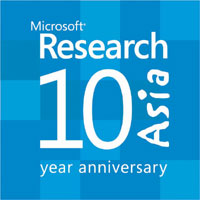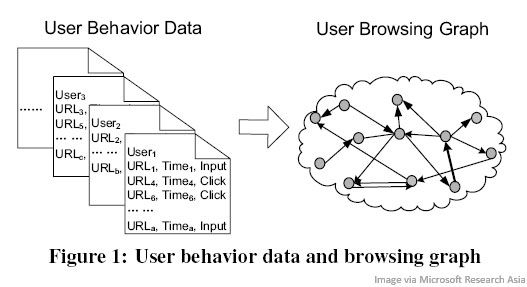pagerank

According to CNET a new paper out of Microsoft Research Asia (PDF) details what may eventually be Microsoft’s answer to the Google PageRank algorithm that was in a large part responsible for the Mountain View-based company’s ascension to the search engine throne. Microsoft’s version, called BrowseRank, would rank pages based on user behavior and not based on linking.
根据CNET的报道,微软亚洲研究部( PDF )的一篇新论文详细介绍了微软最终对Google PageRank算法的答案,这在很大程度上负责了这家基于山景城公司的搜索引擎宝座的提升。 微软的版本称为BrowseRank,它将根据用户行为而不是基于链接对页面进行排名。
The basic idea behind Google’s PageRank is that the more a page is linked to, the most important it must be. Microsoft says that link analysis algorithms like PageRank are flawed, though, because they’re easy to be gamed and don’t take user behavior into consideration. Of course, Google’s actual implementation of PageRank is far from that simplistic and the company updates its search algorithms hundreds of time each year. Further, Google reminds us often that PageRank is just one of many things that it uses to rank search results.
Google的PageRank背后的基本思想是,页面链接到的链接越多,它必须是最重要的。 微软表示,像PageRank这样的链接分析算法是有缺陷的,因为它们很容易被玩耍并且没有考虑用户行为。 当然,Google的PageRank的实际实现绝非如此简单,该公司每年都会数百次更新其搜索算法。 此外,Google经常提醒我们,PageRank只是它用于对搜索结果进行排名的众多功能之一。
Still, Microsoft thinks that it can do better — and it better hope that it can do a lot better. As we discussed earlier beating Google with technology means you have to beat the pants off of them and really wow users with dramatically better search results.
不过,微软认为它可以做的更好-它更好地希望它能够做得更好 。 正如我们之前讨论的,用技术击败Google意味着您必须脱颖而出,才能真正让用户赞叹不已,其搜索结果要好得多。

Microsoft Research Asia’s BrowseRank algorithm ditches the link graph model that was popularized by Google, and instead creates a user browsing graph that looks at things like which links users clicked on and how long they stayed on each page.
Microsoft Research Asia的BrowseRank算法会挖沟Google流行的链接图模型,而是创建一个用户浏览图,以查看用户单击了哪些链接以及在每个页面上停留了多长时间。
“User behavior data can be recorded by Internet browsers at web clients and collected at a web server,” according to the researchers. Microsoft Research Asia said they gathered anonymous data from an “extremely large group of users under legal agreements with them” to put their theory to the test. The idea is that you can take anonymous browsing data from hundreds of millions of users and create a user browsing graph that can paint a picture of which pages are most important to users.
研究人员说:“用户行为数据可以通过Internet浏览器在Web客户端上记录,并在Web服务器上收集。” 微软亚洲研究部表示,他们从“根据与他们达成的法律协议中的极大用户群中收集了匿名数据”,以检验他们的理论。 这个想法是,您可以从亿万用户中获取匿名浏览数据,并创建一个用户浏览图,以绘制出对用户来说最重要的页面的图片。
“The user browsing graph can more precisely represent the web surfer’s random walk process, and thus is more useful for calculating page importance. The more visits of the page made by the users [sic] and the longer time periods spent by the users on the page, the more likely the page is important,” say the researchers. “With this graph, we can leverage hundreds of millions of users’ implicit voting on page importance. In this regard, our approach is in accordance with the concept of Web 2.0.”
“用户浏览图可以更精确地表示网络冲浪者的随机游走过程,因此对于计算页面重要性更为有用。 研究人员说:“用户对页面的访问次数越多,用户在页面上花费的时间越长,页面的重要性就越大。” “使用此图,我们可以利用亿万用户对页面重要性的隐式投票 。 在这方面,我们的方法符合Web 2.0的概念。”
Of course, by itself, user browsing behavior probably isn’t enough to rank pages — if BrowseRank was used on its own, it would be easy to see MySpace and Facebook and video sites like Hulu shoot to the top of search results pages. However, Microsoft researchers think that it could be combined with other web page ranking algorithms to greatly enhance search results. “It is also possible to combine link graph and user behavior data to compute page importance,” they write. Researchers said that initial results from their tests using BrowseRank showed better performance than existing methods.
当然,就其本身而言,用户的浏览行为可能不足以对页面进行排名-如果单独使用BrowseRank,则很容易看到MySpace和Facebook和Hulu之类的视频网站登上搜索结果页面的顶部。 但是,微软研究人员认为,可以将其与其他网页排名算法结合使用,以大大增强搜索结果。 他们写道:“还可以将链接图和用户行为数据结合起来以计算页面重要性。” 研究人员说,他们使用BrowseRank进行测试的初步结果显示,其性能要优于现有方法。
It wouldn’t be surprising to learn that Google had something similar under development. Google is already capturing user browsing behavior via its popular Google Toolbar, and appears to have put some of that data to use earlier this year with the launch of Ad Planner and enhancements to Google Trends that include web traffic. Using that data in search engine results rankings — or at least experimenting with doing so — isn’t a huge leap. Google is hardly a sleeping giant.
得知Google正在开发类似的东西也就不足为奇了。 Google已经通过其流行的Google工具栏捕获了用户的浏览行为,并且随着Ad Planner的推出以及包括网络访问量在内的Google Trends的增强,似乎已经在今年早些时候使用了其中的一些数据。 在搜索引擎结果排名中使用该数据(或至少尝试这样做)并不是一个巨大的飞跃。 Google几乎不是沉睡的巨人。
翻译自: https://www.sitepoint.com/microsofts-answer-to-pagerank-browserank/
pagerank





















 880
880











 被折叠的 条评论
为什么被折叠?
被折叠的 条评论
为什么被折叠?








